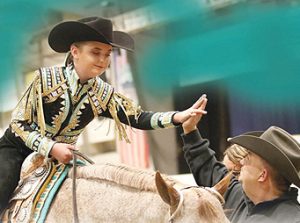Day Fees Demystified – Straight Talk on What Day Fees Encompass
Click here to read the complete article132 – March/April 2019
BY DELORES KUHLWEIN
 If you have a horse trainer, you likely already pay to board your horse, keep it in training, and, when it’s time to go to the horse show, mileage to the event, plus all the expenses associated with competition. When you get your bill for the show, day fees are yet another item on the list of expenses. But what exactly do they cover? It’s often a confusing topic for those new to the industry, and some experienced competitors, and day fees can also vary from trainer to trainer.
If you have a horse trainer, you likely already pay to board your horse, keep it in training, and, when it’s time to go to the horse show, mileage to the event, plus all the expenses associated with competition. When you get your bill for the show, day fees are yet another item on the list of expenses. But what exactly do they cover? It’s often a confusing topic for those new to the industry, and some experienced competitors, and day fees can also vary from trainer to trainer.
Our veteran trainers are here to set the record straight on day fees and how their expenses and workload change from a day in the barn compared to a day at the horse show.
THE TANGIBLES
For experienced exhibitors, it’s understood that there are extra expenditures associated with showing horses. The additional costs for clients begin with those expenses like hotels, meals, and rental cars. With trainers, it’s the same scenario. Being on the road suddenly increases overhead a great deal, and it, starts the moment a truck and trailer pulls out of the driveway. Just plain wear and tear on a trainer’s rig is a start. “It does cost us more, as trainers, when we’re on the road, and that’s why we have to charge those fees,” explains Arturo Maestas of Maestas Show Horses in Pilot Point, Texas.
However, day fees only cover a portion of those expenses, explain Judd and Jennifer Paul of IronGate Quarter Horses of Croton, Ohio. The measurable and concrete costs are easier for clients to understand, such as grooming supplies, stable supplies, and a portion of meals for the trainers and staff. “On any given weekend, we will have four workers at a horse show, counting both of us,” the Pauls say. “For us, supplies are one of the biggest expenses,” adds Taft Dickerson of Donnie Dickerson Quarter Horses in Mount Airy, North Carolina. “We took our meals out of the day fees recently, though we had done it for the last twenty years,” he says.
Horse show supplies aren’t thought about much, but Maestas lists basics, such as tack room racks, feed buckets, water buckets, and rubber mats. Some of the essential “visible” show expenses are listed separately on invoices. For many trainers, this includes hotel fees, stipends for meals, tack stall splits, braiding and banding services, feed and shavings, extra labor for stall cleaning, night watchman pay, and hauling. “Some trainers may charge a separate grooming expense,” the Pauls add.
“Most of these billable expenses are for money we collect and directly pay out,” explains David and Cheryl Busick of Busick Quarter Horses of Livermore, California. “There’s not a profit, except for hauling, unless we break down!”
Click here to read the complete article132 – March/April 2019










